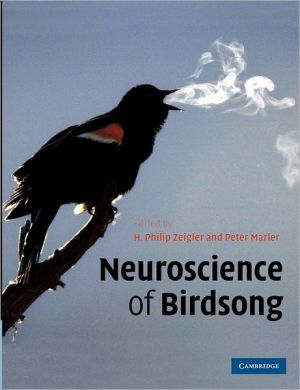

 |

|

Sold Out
Book Categories |
Part I. Foundations: Singing and the Brain: 1. Introduction H. P. Zeigler; 2. Birdsong and human speech Alison Doupe and Pat Kuhl; 3. Birdsong and singing behavior Heather Williams; 4. The Australian Magpie (Gymnorhina tibicen): an alternative model for the study of songbird neurobiology Gisela Kaplan; 5. Songbirds and the revised avian brain nomenclature Anton Reiner, David J. Perkel, Claudio V. Mello and Erich D. Jarvis; 6. The songbird brain in comparative perspective Michael Farries and David. J. Perkel; Part II. Song Production and its Neural Control: 7. Introduction H. P. Zeigler; 8. Mechanisms of song production in songbirds Roderick A. Suthers and Sue Ann Zollinger; 9. Peripheral sensorimotor mechanisms and the control of song Franz Goller and Brenton G. Cooper; 10. Integrating breathing and singing: forebrain and brainstem mechanisms Marc F. Schmidt and Robin Ashmore; 11. Birdsong: anatomical foundations and central mechanisms of sensorimotor integration J. Martin Wild; Part III. Hearing and Recognizing the Song: 12. Introduction Peter Marler; 13. Song selectivity and the songbird brain Frédéric E. Theunissen, Noopur Amin, Sarita Shaevitz, Sarah M. N. Woolley, Thane Fremouw and Mark E. Hauber; 14. Song-selective neurons: synaptic mechanisms and functional roles J. F. Prather and Richard Mooney; 15. Temporal auditory pattern recognition in songbirds Tim Gentner; Part IV. Learning the Song: Mechanisms of Acquisition and Maintenance: 16. Introduction Peter Marler; 17. Comparative aspects of song learning Henrike Hultsch and Dietmar Todt; 18. Developmental song learning in the zebra finch Sigal Saar, Partha P. Mithra, Sebastien Deregnaucourt and Ofer Tchernichovski; 19. Auditory feedback and singing in adult birds Sarah M. N. Woolley; 20. The anterior forebrain pathway and vocal plasticity Michael S. Brainard; 21. Circuits and cellular mechanisms of sensory acquisition Kathy and Ernest Nordeen; 22. Chasin' the trace: the neural substrate of birdsong memory Johan J. Bolhuis; 23. The template concept - crafting a song replica from memory Patrice Adret; Part V. Mechanisms of Modulation and Plasticity: 24. Introduction Peter Marler; 25. Hormonal modulation of singing behavior: methodology and principles of hormone action Cheryl F. Harding; 26. Sex differences in brain and behavior and neuroendocrine control of the motivation to sing Gregory F. Ball, Lauren V. Riters, Scott A. MacDougall-Shackleton and J. Balthazart; 27. Plasticity of the song control system in adult birds Eliot Brenowitz; 28. Regulation and function of neuronal replacement in the avian song system Carolyn Pytte, Linda Wilbrecht and John R. Kirn; Part VI. The Genomic Revolution and Birdsong Neurobiology: 29. Introduction H. P. Zeigler; 30. Studies of songbirds in the age of genetics: what to expect from genomic approaches in the next 20 years David F. Clayton and Arthur P. Arnold; 31. Behavior-dependent expression of inducible genes in vocal learning birds Claudio V. Mello and Erich D. Jarvis; 32. Genes for tuning up the vocal brain: FoxP2 in human speech and birdsong Sebastian Haesler and Constance Scharff; Part VII. On a Personal Note: 33. Introduction H. P. Zeigler; 34. William Homans Thorpe: a biographical memoir R. A. Hinde; 35. My journey with birdsong M. Konishi; 36. The discovery of replaceable neurons Fernando Nottebohm; 37. The birdsong saga Peter Marler; Part VIII. Collected References.
Login|Complaints|Blog|Games|Digital Media|Souls|Obituary|Contact Us|FAQ
CAN'T FIND WHAT YOU'RE LOOKING FOR? CLICK HERE!!! X
 You must be logged in to add to WishlistX
 This item is in your Wish ListX
 This item is in your CollectionNeuroscience of Birdsong
X
 This Item is in Your InventoryNeuroscience of Birdsong
X
 You must be logged in to review the productsX
 X
 X

Add Neuroscience of Birdsong, Speech has long been thought of as a uniquely defining characteristic of humans. Yet song birds, like humans, communicate using learned signals (song, speech) that are acquired from their parents by a process of vocal imitation. Both song and speech begin, Neuroscience of Birdsong to the inventory that you are selling on WonderClubX
 X

Add Neuroscience of Birdsong, Speech has long been thought of as a uniquely defining characteristic of humans. Yet song birds, like humans, communicate using learned signals (song, speech) that are acquired from their parents by a process of vocal imitation. Both song and speech begin, Neuroscience of Birdsong to your collection on WonderClub |